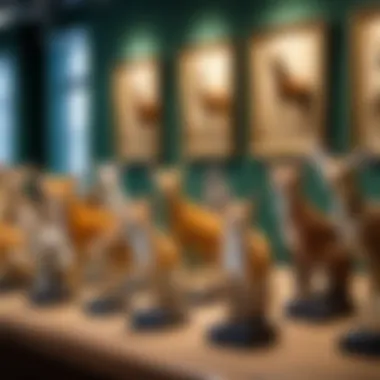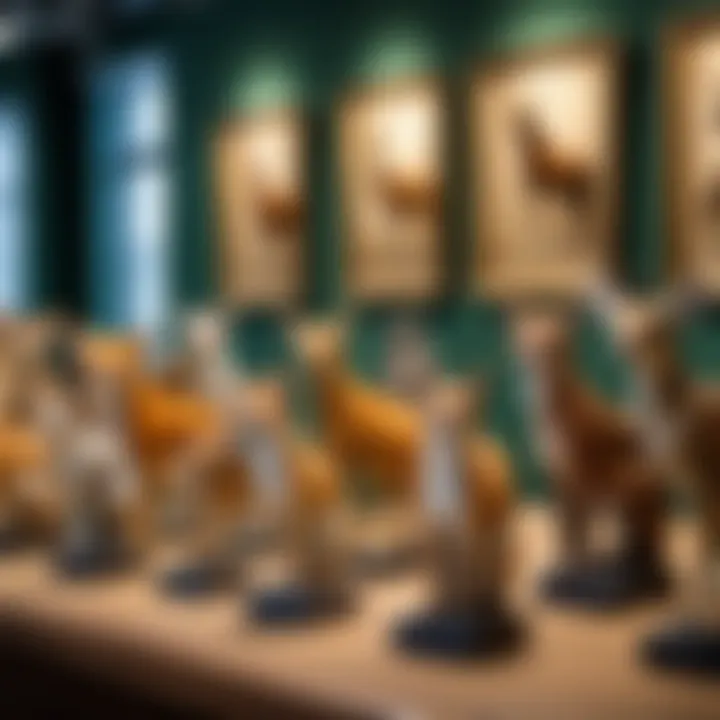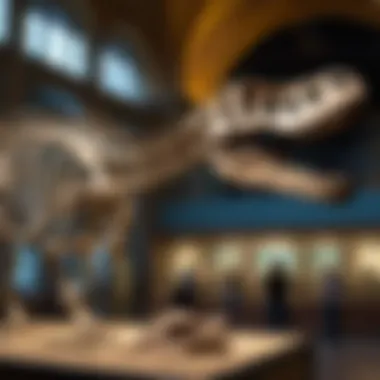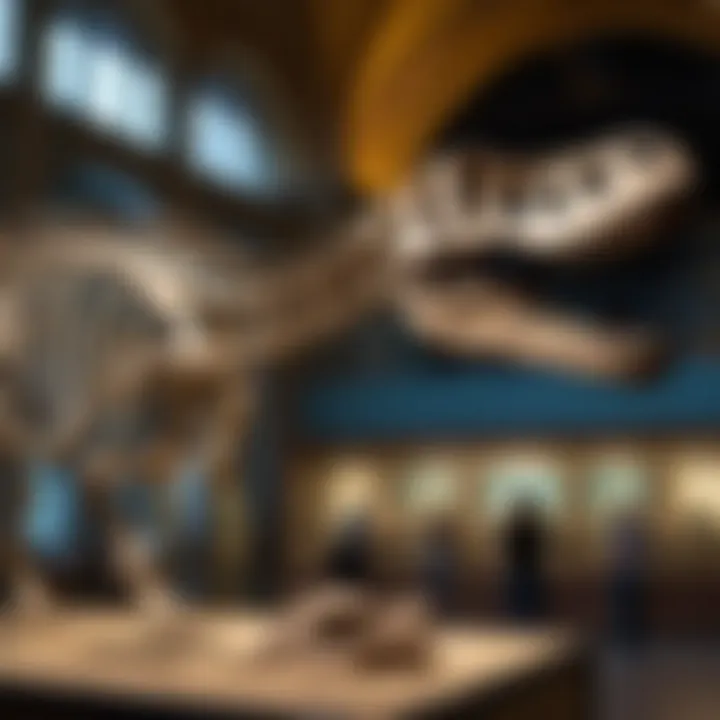Exploring St. Petersburg's Zoological Museum: Admission Details


Intro
The Zoological Museum in St. Petersburg stands as a key institution for those who are fascinated by natural history. This museum showcases a diverse collection of fauna from across the globe. For visitors interested in understanding the animal kingdom's vastness, this museum provides an invaluable experience. Within its walls, one can find skeletons, taxidermy specimens, and preserved remains that tell stories of life on our planet.
As you plan your visit, it’s important to be aware of ticket prices and other essentials. Knowing what to expect can enhance your experience and ensure you make the most of your time at the museum. This article aims to provide you with a thorough understanding of the museum’s offerings, practical visitor information, and the significance of the Zoological Museum within the context of St. Petersburg's rich cultural landscape.
Preamble to the Zoological Museum
The Zoological Museum in St. Petersburg holds great significance in the realm of natural history. It serves as a bridge connecting visitors to the rich biodiversity of the planet. This museum is not just a collection of specimens; it is a narrative of life on Earth, showcasing the awe of evolution and the complexity of ecosystems. For many tourists and locals alike, the museum offers an opportunity to engage intimately with nature and science.
Understanding the historical and cultural background of the museum enhances the visiting experience. The displays range from extinct species to living relatives, facilitating a deep appreciation for wildlife conservation. In this section, we will delve into the historical context of the museum as well as its mission and vision, both essential in comprehending its current role in education and research.
Historical Context
The foundation of the Zoological Museum dates back to the 18th century, when Russian naturalists began developing the study of zoology. Its establishment was part of a larger movement to categorize and understand the diverse forms of life present in Russia and beyond. Over the years, the museum has evolved significantly, accumulating a vast array of collections that now spans multiple continents and climates.
In its early years, the museum focused primarily on the species native to Russia. As global exploration expanded, so did the museum's holdings, gradually incorporating exotic species from around the world. Today, the museum possesses over 30,000 specimens, including both preserved and mounted animals. Each specimen tells a story, contributing to the museum's narrative of animal life.
Museum's Mission and Vision
The Zoological Museum operates under a mission to educate the public about zoology and promote the importance of conservation. The museum's vision extends beyond mere exhibitions; it aims to foster a sense of responsibility towards the environment. Through its diverse exhibitions and programs, the museum inspires visitors to respect and protect wildlife across the globe.
In particular, the museum emphasizes research and collaboration with various institutions. It continuously seeks partnerships to enhance its educational offerings and scientific knowledge. Visitors are often provided insights into ongoing research projects, making each visit a learning opportunity. This commitment to education and conservation reflects the museum's integral role in both the local and global community.
"The Zoological Museum is more than just an exhibition space; it is a vital institution that educates and engages the public in pressing ecological issues."
Overview of Exhibits
The exhibit space in the Zoological Museum of St. Petersburg offers a deep insight into the diversity of the animal kingdom. This section serves as the heart of the museum, showcasing its commitment to education and research in natural history. Each exhibit tells a story, allowing visitors to explore the world's biodiversity. Understanding the various exhibitions helps visitors appreciate the museum's role in conservation and educational outreach.
Permanent Exhibitions


The permanent exhibitions of the Zoological Museum are a treasure trove of information. These displays often highlight a wide range of fauna, from local species to exotic animals. They are meticulously curated to provide visitors with both visual enjoyment and educational content. Key themes include evolutionary biology and the adaptation of species to various habitats.
Such collections often feature detailed taxidermy, which contributes not only to aesthetic appeal but also to scientific documentation. The taxidermy process, coupled with educational placards, helps foster a better understanding of each species' ecology and behavior. Visitors can expect to see well-documented species like the Siberian tiger and various types of birds native to Russia. This curation helps visitors create connections to the wildlife they may observe in nature.
Temporary Exhibitions
Temporary exhibitions in the museum supplement the permanent displays and introduce new themes and topics. These rotating exhibits are essential for keeping the museum relevant and engaging. Often centered around current environmental issues, these exhibitions allow for dialogue on conservation topics, endangered species, and the impact of climate change.
For example, a visiting exhibit might focus on the role of pollinators in ecosystems. This gives patrons a fresh perspective and encourages them to reflect on pressing ecological concerns. Temporary exhibits add variety to the museum experience, prompting repeat visits and fostering a sense of community engagement. They are often linked to educational programs designed for schools or special community events.
Notable Specimens
Several notable specimens housed within the museum are often highlights for visitors. These specimens hold significant scientific value or represent pivotal moments in zoological study. Among them, the preserved giant squid is often cited as a remarkable attraction. It provides insights into marine biology and deep-sea ecosystems. Another widely admired specimen is the woolly mammoth, which captures the imagination and serves as a direct link to prehistoric times.
Visitors can gain a deep appreciation for the work of scientists who studied these creatures. Furthermore, notable specimens are often accompanied by interactive displays that engage visitors of all ages. This promotes a deeper understanding of the importance of biodiversity and the role of each organism within its ecosystem.
"Every exhibit is an invitation to explore the natural world, inspiring curiosity and fostering appreciation for life in all its forms."
In summary, the overview of exhibits at the Zoological Museum in St. Petersburg offers visitors a comprehensive and enriching experience. Each section within the exhibit space contributes to a greater understanding of zoology and conservation efforts, ensuring that the museum remains a vital educational resource.
Ticket Prices and Admission Policies
Understanding the ticket prices and admission policies at the Zoological Museum in St. Petersburg is critical for anyone planning a visit. Knowing the costs associated with entry can help visitors budget effectively, ensuring a more enjoyable experience. Moreover, familiarity with special policies regarding discounts or group rates enhances accessibility, allowing diverse audiences to engage with the museum’s rich offerings.
General Admission Prices
The general admission price for the Zoological Museum is structured to accommodate a range of visitors. As of now, the ticket price is set at 400 rubles for adults. For students and seniors, a reduced fee of 200 rubles applies. Children under the age of 7 are granted free entry, which is an important aspect for families visiting the museum. This tiered pricing strategy helps ensure that educational resources are available to a wider audience, promoting inclusivity and encouraging learning about nature and wildlife.
Discounts and Free Admission Days
The museum implements various discounts and free admission days throughout the year. Notably, certain days, like International Museum Day or the museum’s anniversary, often feature free entry for everyone. Discounts are also available for groups exceeding ten people, with a special rate of 150 rubles per person. This makes it easier for schools and organized groups to participate in cultural education. Check the museum's official website or social media pages for updates on these promotions, as they can vary yearly.
Group Visits and Special Rates


When organizing a group visit to the Zoological Museum, special considerations come into play. Groups of 15 or more can take advantage of tailored guided tours, complete with a dedicated guide who can provide in-depth commentary on the exhibits. Special rates apply in these cases, often around 300 rubles per person. This aspect not only enhances the educational experience but also promotes engagement among group members.
"To maximize your group’s experience, it is advisable to book in advance. This guarantees availability and ensures a well-planned visit, allowing for the most effective use of your time at the museum."
Planning ahead for ticket purchases and understanding admission policies means visitors can concentrate on enjoying their time exploring the museum rather than concerning themselves with logistics. For seasoned travelers and newcomers alike, a thorough understanding of ticket prices and admission policies adds significant value to the overall experience.
Visitor Information
Visitor information is a critical component when planning a trip to the Zoological Museum in St. Petersburg. It provides essential details that help to enhance the overall experience for tourists. Knowing the opening hours ensures that visitors can allocate appropriate time for exploration without feeling rushed. Accessibility information allows people with mobility needs to navigate the museum comfortably. Additionally, understanding available guided tours and educational programs can enrich a visitor's experience, offering deeper insights into the exhibits.
Each of these elements plays a significant role in shaping a satisfying visit. By equipping travelers with practical details, it makes the entire experience more enjoyable and educational.
Opening Hours
The Zoological Museum operates on a schedule that is designed to accommodate a variety of guests. Generally, it is open from 10 AM to 6 PM, with the last entry at 5:30 PM. This allows ample time for exploration during the day. On weekends, the museum may experience increased foot traffic. Hence, it is advisable to arrive earlier to enjoy a more relaxed visit.
Location and Accessibility
Situated in the heart of St. Petersburg, the Zoological Museum is easily accessible via public transport. The nearest metro station is Admiralteyskaya, which is just a short walk away. The museum is located at Universitetskaya nab., 1, near the Neva River.
Accessibility features are also available. Wheelchair ramps and accessible bathrooms are provided to ensure that everyone can enjoy the exhibits without difficulty. This consideration makes the museum welcoming to a wider audience, including individuals with disabilities and families with strollers.
Guided Tours and Educational Programs
For those looking to deepen their understanding of natural history, guided tours are offered. These tours are led by knowledgeable staff who can provide context and interesting anecdotes about the exhibits. They usually last around an hour, allowing sufficient time to delve into key themes without overwhelming visitors.
Educational programs are also a part of the museum's offerings. These can include workshops, lectures, and hands-on activities designed for school groups and individuals alike. Such programs provide unique opportunities to engage with the material in a meaningful way. For more information on available programs and to book a tour, visitors can check the museum's official page or contact the staff directly.
Guided tours and educational programs enrich your understanding and appreciation of exhibits. These experiences often highlight unique aspects that may go unnoticed during a self-guided tour.
Planning Your Visit


When planning a visit to the Zoological Museum in St. Petersburg, it is crucial to consider various factors to make the experience enjoyable and fulfilling. The timing of your visit plays a significant role in how you perceive the exhibits and overall ambiance of the museum. Additionally, knowing about nearby attractions can enhance your itinerary and provide a more rounded cultural experience. Practical tips can also help you navigate the museum effectively.
Best Times to Visit
Choosing the best time to visit the Zoological Museum allows for a more pleasant experience. Typically, weekdays are less crowded compared to weekends, especially during peak tourist season. Early mornings often provide a quieter atmosphere, allowing for better contemplation of the exhibits.
If you prefer a less busy environment, consider visiting during off-peak months. In St. Petersburg, this usually includes late fall and winter. Weather can influence visitor numbers, so colder months might offer a more intimate experience at the museum.
Nearby Attractions
The Zoological Museum is strategically located near several notable attractions, making it an ideal starting point for a cultural tour.
- Russian Museum: Known for its extensive collection of Russian art, including masterpieces from the 11th to the 20th century.
- Field of Mars: A historical park that provides a nice break from museum visits. Its vast greenery is perfect for a peaceful stroll.
- Saint Isaac's Cathedral: This magnificent structure boasts a stunning dome and beautiful interior, worth a visit.
Incorporating these sites into your itinerary can offer a richer experience.
Tips for a Successful Visit
To maximize your time at the Zoological Museum, consider the following tips:
- Plan Ahead: Review the museum's website for any special exhibits or activities that may require advance booking.
- Guided Tours: If possible, take advantage of guided tours. They provide context and insights that enhance the overall experience.
- Stay Hydrated: Walking through the museum can be exhausting. Bring a bottle of water to stay refreshed.
- Time Management: Allocate enough time for each exhibit, but be flexible. Some displays may captivate you longer than expected.
Remember, a well-planned visit often leads to the most memorable experiences. Take your time to enjoy and reflect on what you see.
End
The conclusion serves as a vital aspect of this article, encapsulating the essence of a visit to the Zoological Museum in St. Petersburg. Understanding the key elements regarding ticket prices, exhibits, and visitor information significantly enhances the experience of potential visitors. The museum, with its vast collection and rich history, represents a critical part of cultural and natural history. Knowing the admission policies promotes easier planning for both novice and experienced tourists alike.
Summary of Key Points
In summary, this article has outlined various facets of the Zoological Museum in St. Petersburg:
- Admission Information: The ticket prices and special rates allow a broader audience to visit, including discounts for students and seniors.
- Exhibits Overview: A detailed look into the permanent and temporary exhibitions highlights the diverse natural specimens, catering to all ages and interests.
- Visitor Information: Specific details such as opening hours, location, and available educational programs ensure visitors can plan a fruitful trip.
Final Recommendations
For an enriching visit to the Zoological Museum, consider the following recommendations:
- Plan Ahead: Check the museum's official website for the latest on ticket prices and exhibit schedules before your visit to avoid surprises.
- Consider Timing: Visiting during weekdays might offer a quieter experience with fewer crowds, allowing for a more personal interaction with the exhibits.
- Engage in Tours: If possible, join a guided tour to deepen your understanding of the exhibits and their significance in natural history. This could substantiate your knowledge and appreciation of the museum's offerings.







